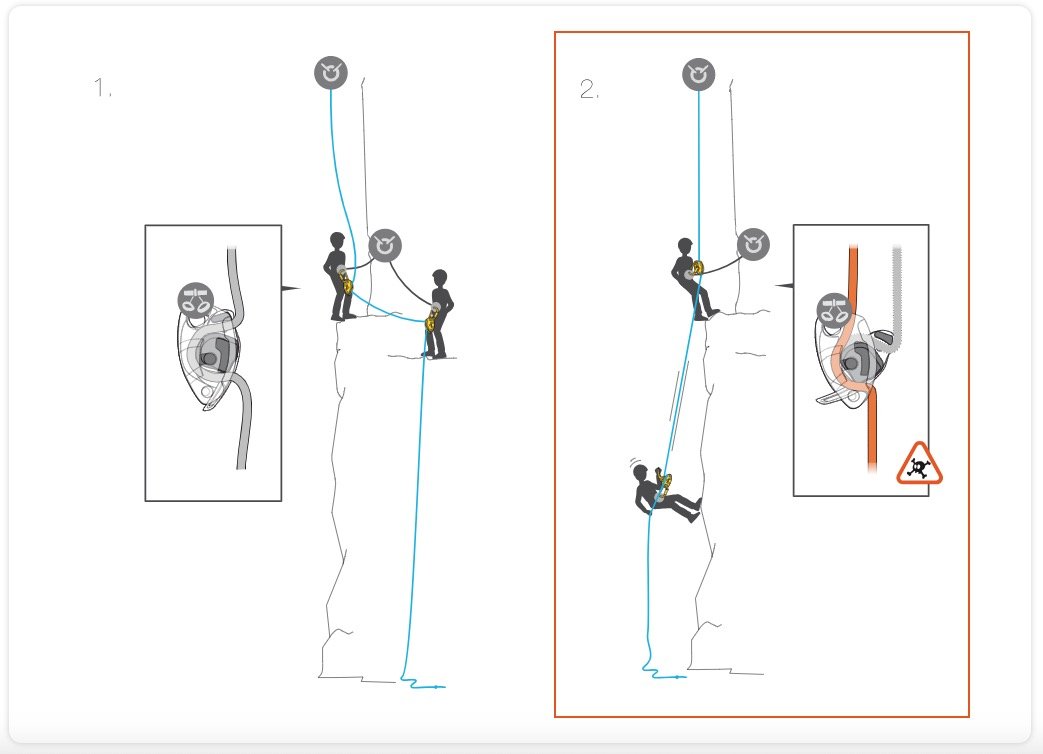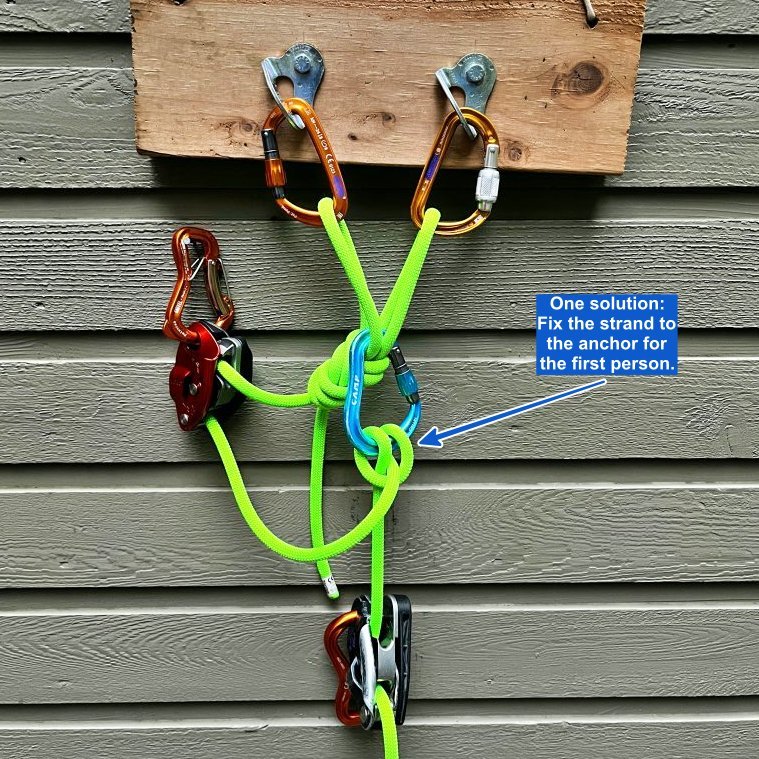Don't pre-rig a rappel with a Grigri on top
The pre-rigged (aka “stacked”) rappel, is a technique where both partners rig their rappel device at the same time, usually with an extension. Here's a complete article on it. A pre-rigged rappel increases efficiency and (usually) reduces risk.
Increases efficiency: the moment the first person is down the second person can start.
(Usually) reduces risk: the last person gets a safety check.
However, there’s apparently an unusual situation where this might actually increase risk: when the top climber has a Grigri.
The Petzl website awards this a skull and crossbones, which always gets my full attention!
I’d never heard of this until recently (Dec. 2023) , so I want to give it a shout as a potential issue. Thanks to Alpinesavvy fan @timmyycedar for mentioning this to mementioning this to me.
Check out the diagram below from the (always awesome) Petzl website.
The example from Petzl, and the one I show here, uses two Grigris. But it seems to me that the exact problem would still be present no matter what type of device the lower person is using.
Also, there’s no mention of rope diameter. It also seems to me that a smaller diameter rope might be more prone to this problem, I really don't know.
Here’s the caution from Petzl against doing a stacked rappel with certain flavors of the Grigri (bold text mine).
“With the GRIGRI + from 2017 and on, and the GRIGRI from 2019 and on, unblocking and a consequent fall can occur if the rope is heavily loaded below the user. Unblocking can occur if the rope is loaded with a weight equal to or greater than that of the person rappelling on the GRIGRI.
Examples of dangerous situations:
Multiple people rappelling in sequence, GRIGRIs pre-installed on the rope. If the person waiting in turn to rappel has their GRIGRI pre-installed on the rope, it can be inverted (and thus unblocked) by the weight of the person rappelling below them. So it will not be operational when the second person wants to start their rappel.
Bottom belay: the person performing the belay maneuver must not hang on the rope.
Rescue from below: The rescuer must not ascend the rope of a person who is stuck on rappel.”
IMAGE: HTTPS://WWW.PETZL.COM/US/EN/SPORT/RAPPELLING-WITH-THE-GRIGRI?PRODUCTNAME=GRIGRI-PLUS
Apparently there are two other situations that can also cause Grigri failure. Check out the diagram below.
On the left, if someone gives an overly enthusiastic “firefighter belay” by putting their full weight on the rope, apparently that may cause Grigri failure.
Related to this, if someone is stuck on rappel and the climber at the bottom wants to ascend the rope, putting their full weight on it may cause Grigri failure.
IMAGE: HTTPS://WWW.PETZL.COM/US/EN/SPORT/RAPPELLING-WITH-THE-GRIGRI?PRODUCTNAME=GRIGRI-PLUS
OK, that's the doom and gloom stuff. Let's look at some simple ways to avoid this problem.
First off, this really only applies to descending a single strand of rope. It's pretty rare to do this in a normal climbing situation, so most people will never encounter this set up to begin with.
If one partner has a tube style device: set up your pre-rigged rappel so the first person down is always on the Grigri, and anyone else going down uses a tube device.
There are various other benefits for the first person down to use a Grigri, such as hands-free rope detangling, doing a pendulum if needed to reach an anchor off to the side, easily ascending the rope if needed, etc. Now we have one more reason to use this method.
If you MUST rappel single strand with two Grigris, there are other solutions.
Don't do a pre-rigged rappel, Easy!
If you do pre-rig, you can tie the rope to the anchor with a clove hitch (blue carabiner) , as shown below. This means the weight of rappeler #1 goes on the anchor, and not onto rappeler #2. This eliminate any chance of Grigri failure. Rappeler #2 removes the clove, cleans the blue carabiner, and rappels.
Here is a video clip showing how the failure actually happens. This was sent to me by @govanathon, thanks!
(Actual failure / device inversion starts about 1:50.)




